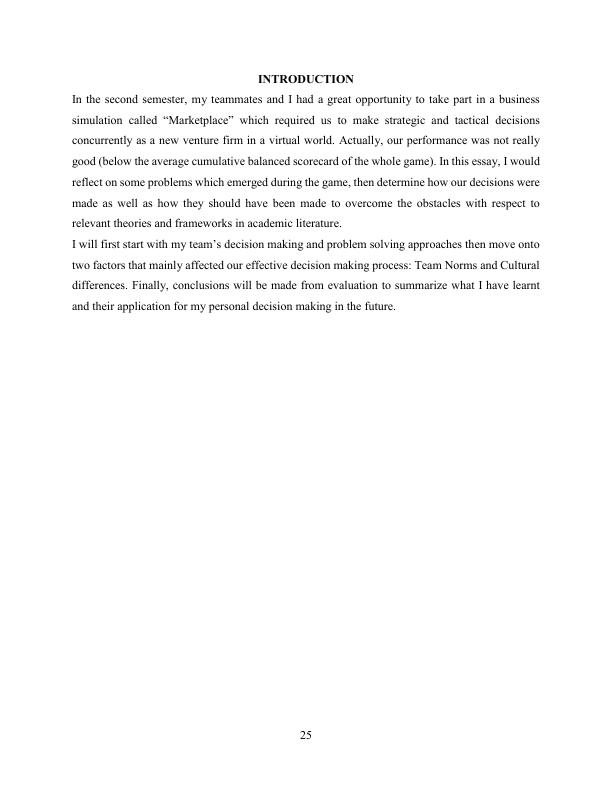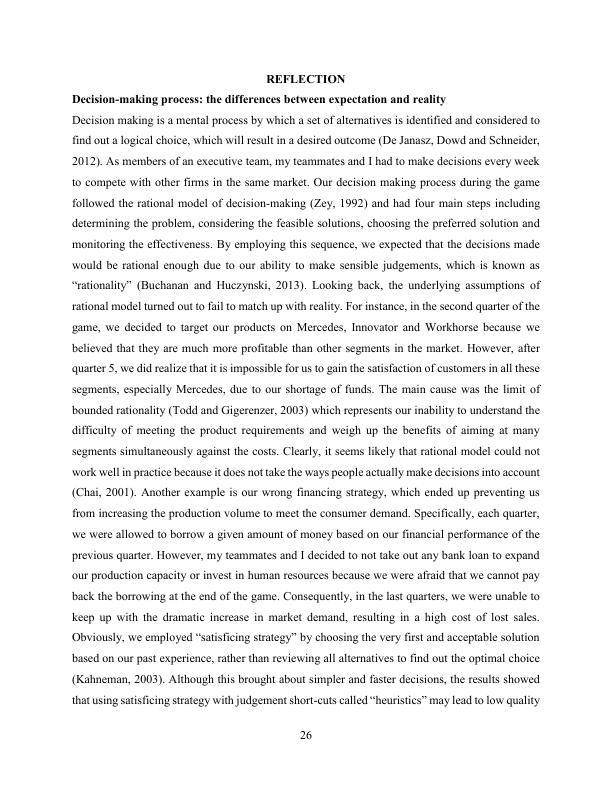Integrated Business Decisions PDF
Added on 2022-01-15
13 Pages4013 Words79 Views
23
MODULE NAME (NBS- MC2X) Integrated Business Decisions
STUDENT ID NUMBER 100144422
WORD COUNT 2,196
MODULE NAME (NBS- MC2X) Integrated Business Decisions
STUDENT ID NUMBER 100144422
WORD COUNT 2,196

24
TABLE OF CONTENTS
INTRODUCTION....................................................................................................................... 25
REFLECTION ............................................................................................................................ 26
Decision-making process: the differences between expectation and reality...................... 26
The effects of biases on problem solving process ................................................................. 27
Enforcement of team norms and Participative decision making style............................... 28
Multicultural group: the difference in uncertainty orientation ......................................... 29
CONCLUSION ........................................................................................................................... 31
APPENDICES ............................................................................................................................. 32
REFERENCES............................................................................................................................ 34
TABLE OF CONTENTS
INTRODUCTION....................................................................................................................... 25
REFLECTION ............................................................................................................................ 26
Decision-making process: the differences between expectation and reality...................... 26
The effects of biases on problem solving process ................................................................. 27
Enforcement of team norms and Participative decision making style............................... 28
Multicultural group: the difference in uncertainty orientation ......................................... 29
CONCLUSION ........................................................................................................................... 31
APPENDICES ............................................................................................................................. 32
REFERENCES............................................................................................................................ 34

25
INTRODUCTION
In the second semester, my teammates and I had a great opportunity to take part in a business
simulation called “Marketplace” which required us to make strategic and tactical decisions
concurrently as a new venture firm in a virtual world. Actually, our performance was not really
good (below the average cumulative balanced scorecard of the whole game). In this essay, I would
reflect on some problems which emerged during the game, then determine how our decisions were
made as well as how they should have been made to overcome the obstacles with respect to
relevant theories and frameworks in academic literature.
I will first start with my team’s decision making and problem solving approaches then move onto
two factors that mainly affected our effective decision making process: Team Norms and Cultural
differences. Finally, conclusions will be made from evaluation to summarize what I have learnt
and their application for my personal decision making in the future.
INTRODUCTION
In the second semester, my teammates and I had a great opportunity to take part in a business
simulation called “Marketplace” which required us to make strategic and tactical decisions
concurrently as a new venture firm in a virtual world. Actually, our performance was not really
good (below the average cumulative balanced scorecard of the whole game). In this essay, I would
reflect on some problems which emerged during the game, then determine how our decisions were
made as well as how they should have been made to overcome the obstacles with respect to
relevant theories and frameworks in academic literature.
I will first start with my team’s decision making and problem solving approaches then move onto
two factors that mainly affected our effective decision making process: Team Norms and Cultural
differences. Finally, conclusions will be made from evaluation to summarize what I have learnt
and their application for my personal decision making in the future.

26
REFLECTION
Decision-making process: the differences between expectation and reality
Decision making is a mental process by which a set of alternatives is identified and considered to
find out a logical choice, which will result in a desired outcome (De Janasz, Dowd and Schneider,
2012). As members of an executive team, my teammates and I had to make decisions every week
to compete with other firms in the same market. Our decision making process during the game
followed the rational model of decision-making (Zey, 1992) and had four main steps including
determining the problem, considering the feasible solutions, choosing the preferred solution and
monitoring the effectiveness. By employing this sequence, we expected that the decisions made
would be rational enough due to our ability to make sensible judgements, which is known as
“rationality” (Buchanan and Huczynski, 2013). Looking back, the underlying assumptions of
rational model turned out to fail to match up with reality. For instance, in the second quarter of the
game, we decided to target our products on Mercedes, Innovator and Workhorse because we
believed that they are much more profitable than other segments in the market. However, after
quarter 5, we did realize that it is impossible for us to gain the satisfaction of customers in all these
segments, especially Mercedes, due to our shortage of funds. The main cause was the limit of
bounded rationality (Todd and Gigerenzer, 2003) which represents our inability to understand the
difficulty of meeting the product requirements and weigh up the benefits of aiming at many
segments simultaneously against the costs. Clearly, it seems likely that rational model could not
work well in practice because it does not take the ways people actually make decisions into account
(Chai, 2001). Another example is our wrong financing strategy, which ended up preventing us
from increasing the production volume to meet the consumer demand. Specifically, each quarter,
we were allowed to borrow a given amount of money based on our financial performance of the
previous quarter. However, my teammates and I decided to not take out any bank loan to expand
our production capacity or invest in human resources because we were afraid that we cannot pay
back the borrowing at the end of the game. Consequently, in the last quarters, we were unable to
keep up with the dramatic increase in market demand, resulting in a high cost of lost sales.
Obviously, we employed “satisficing strategy” by choosing the very first and acceptable solution
based on our past experience, rather than reviewing all alternatives to find out the optimal choice
(Kahneman, 2003). Although this brought about simpler and faster decisions, the results showed
that using satisficing strategy with judgement short-cuts called “heuristics” may lead to low quality
REFLECTION
Decision-making process: the differences between expectation and reality
Decision making is a mental process by which a set of alternatives is identified and considered to
find out a logical choice, which will result in a desired outcome (De Janasz, Dowd and Schneider,
2012). As members of an executive team, my teammates and I had to make decisions every week
to compete with other firms in the same market. Our decision making process during the game
followed the rational model of decision-making (Zey, 1992) and had four main steps including
determining the problem, considering the feasible solutions, choosing the preferred solution and
monitoring the effectiveness. By employing this sequence, we expected that the decisions made
would be rational enough due to our ability to make sensible judgements, which is known as
“rationality” (Buchanan and Huczynski, 2013). Looking back, the underlying assumptions of
rational model turned out to fail to match up with reality. For instance, in the second quarter of the
game, we decided to target our products on Mercedes, Innovator and Workhorse because we
believed that they are much more profitable than other segments in the market. However, after
quarter 5, we did realize that it is impossible for us to gain the satisfaction of customers in all these
segments, especially Mercedes, due to our shortage of funds. The main cause was the limit of
bounded rationality (Todd and Gigerenzer, 2003) which represents our inability to understand the
difficulty of meeting the product requirements and weigh up the benefits of aiming at many
segments simultaneously against the costs. Clearly, it seems likely that rational model could not
work well in practice because it does not take the ways people actually make decisions into account
(Chai, 2001). Another example is our wrong financing strategy, which ended up preventing us
from increasing the production volume to meet the consumer demand. Specifically, each quarter,
we were allowed to borrow a given amount of money based on our financial performance of the
previous quarter. However, my teammates and I decided to not take out any bank loan to expand
our production capacity or invest in human resources because we were afraid that we cannot pay
back the borrowing at the end of the game. Consequently, in the last quarters, we were unable to
keep up with the dramatic increase in market demand, resulting in a high cost of lost sales.
Obviously, we employed “satisficing strategy” by choosing the very first and acceptable solution
based on our past experience, rather than reviewing all alternatives to find out the optimal choice
(Kahneman, 2003). Although this brought about simpler and faster decisions, the results showed
that using satisficing strategy with judgement short-cuts called “heuristics” may lead to low quality

End of preview
Want to access all the pages? Upload your documents or become a member.
Related Documents
Personal Leadership Experience at Fallbarrow Halllg...
|15
|3143
|81
Reflection on My Experience in Room 208lg...
|7
|1836
|37
Managing People : Teamwork Theories Assignmentlg...
|8
|1566
|56
Business Communication Skills - Reflectionlg...
|4
|646
|82
Reflection on Team Projectlg...
|5
|1563
|20
Introduction to Organizational Behaviorlg...
|6
|943
|51
